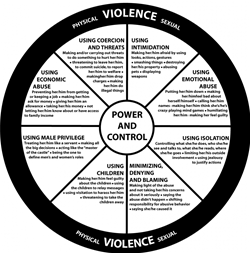Anyone can be a victim of domestic violence. There is NO “typical victim.” Victims of domestic violence comes from all walks of life, varying age groups, all backgrounds, all communities, all education levels, all economic levels, all cultures, all ethnicities, all religions, all abilities, and all lifestyles.
Victims of domestic violence do not bring violence upon themselves, they do not always lack self-confidence, nor are they just as abusive as the abuser. Violence in relationships occurs when one person feels entitled to power and control over their partner and chooses to use abuse to gain and maintain that control. In relationships where domestic violence exists, violence is not equal. Even if the victim fights back or instigates violence in an effort to diffuse a situation. There is always one person who is the primary, constant source of power, control, and abuse in the relationship.
What Makes a Relationship Abusive?
Every relationship differs, but what is most common within all abusive relationships is the varying tactics used by abusers to gain and maintain power and control over the victim. Nearly three in ten women and one in ten men in the United States have experienced rape, physical violence, and/or stalking by an intimate partner (or former partner) and reported at least one impact related to experiencing these or other forms of violence behavior in the relationship (e.g. feeling fearful, concern for safety, post-traumatic stress disorder (PTSD), need for health care, injury, crisis support, need for housing services, need for victim advocacy series, need for legal services, missed work or school).
Physical and sexual assaults, or threats to commit them, are the most apparent forms of domestic violence and are usually the actions that make others aware of the problem. However, regular use of other abusive behaviors by the abuser, when reinforced by one or more acts of physical violence, make up a larger scope of abuse. Although physical assaults may occur only occasionally, they instill fear of future violent attacks and allow the abuser to control the victim’s life and circumstances.
Patterns of Abuse
 Illustrations of the power and control wheel and the post-separation power and control wheel are particularly helpful tools in understanding the overall pattern of abusive and violence behaviors used by abusers to establish and maintain control over their partners both within and following a relationship. Very often, one or more violence incidents are accompanied by an array of these other types of abuse. They are less easily identified, yet firmly establish a pattern of intimidation and control in the relationship.
Illustrations of the power and control wheel and the post-separation power and control wheel are particularly helpful tools in understanding the overall pattern of abusive and violence behaviors used by abusers to establish and maintain control over their partners both within and following a relationship. Very often, one or more violence incidents are accompanied by an array of these other types of abuse. They are less easily identified, yet firmly establish a pattern of intimidation and control in the relationship.
As the wheels illustrate, abuse is cyclical. There are periods of time where things may be calmer, but those times are followed by a buildup of tension and abuse, which usually results in the abuser peaking with intensified abuse. The cycle then often starts to repeat, commonly becoming more and more intense as time goes on. Each relationship is different and not every relationship follows the exact pattern. Some abusers may cycle rapidly, others over longer stretches of time. Regardless, abusers purposefully use numerous tactics of abuse to instill fear in the victim and maintain control over them.
How Does Abuse Affect Victims?
Domestic violence affects all aspects of a victim’s life. When abuse victims are able to safely escape and remain free from their abuser, they often survive with long-lasting and sometimes permanent effects to their mental and physical health; relationships with friends, family, and children; their career; and their economic well-being.
Victims of domestic violence experience an array of emotions and feelings from the abuse inflicted upon them by their abuser, both within and following the relationship. They may also resort to extremes in an effort to cope with the abuse. Victims of domestic violence may:
- Want the abuse to end, but not the relationship
- Feel isolated
- Feel depressed
- Feel helpless
- Be unaware of what services are available to help them
- Be embarrassed of their situation
- Fear judgement or stigmatization if their reveal the abuse
- Deny or minimize the abuse or make excuses for the abuser
- Still love their abuser
- Withdraw emotionally
- Distance themselves from family or friends
- Be impulsive or aggressive
- Feel financially dependent on their abuser
- Feel guilt related to the relationship
- Feel shame
- Have anxiety
- Have suicidal thoughts
- Abuse alcohol or drugs
- Be hopeful that their abuser will change and/or stop the abuse
- Have religious, cultural, or other beliefs that reinforce staying in the relationship
- Have no support from friends of family
- Fear cultural, community, or societal backlash that may hinder escape or support
- Feel like they have nowhere to go or no ability to get away
- Fear they will not be able to support themselves after they escape the abuser
- Have children in common with their abuser and fear for their safety if the victim leaves
- Have pets or other animals they don’t want to leave
- Be distrustful of local law enforcement, courts, or other systems if the abuse is revealed
- Have had unsupportive experiences with friends, family, employers, law enforcement, courts, child protective services, etc. and believe they won’t get help if they leave or fear retribution if they do (e.g. they fear losing custody of their children to the abuser)
These are among the many reasons victims of domestic violence either choose to stay in abusive relationships or feel they are unable to leave. ‘

